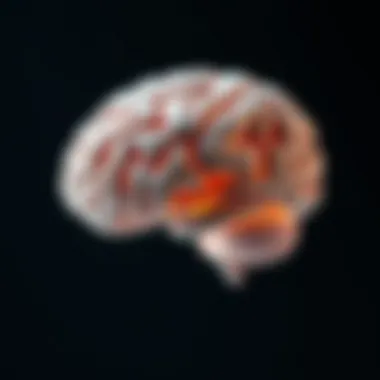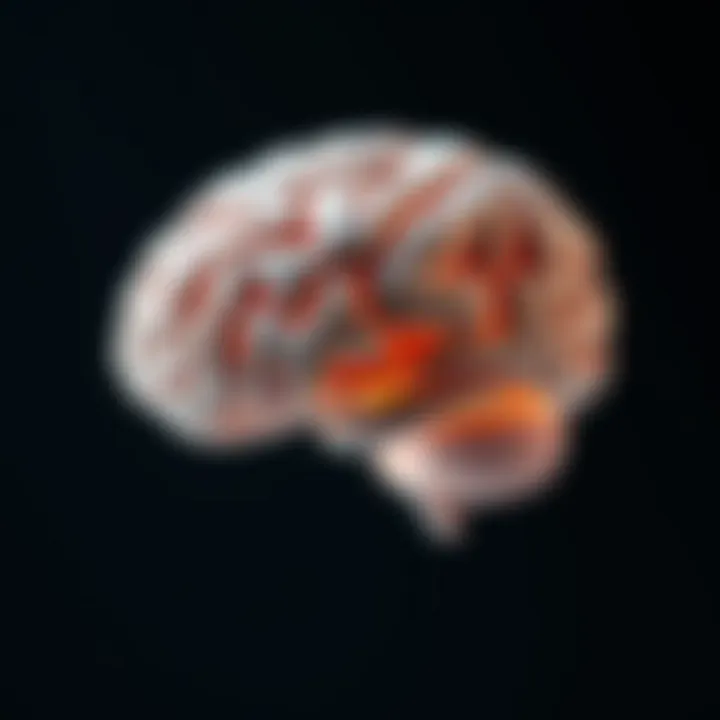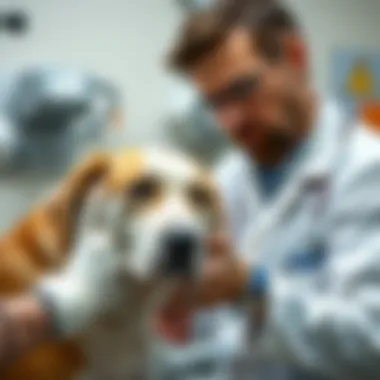Understanding Canine Brain Tumors: Causes, Symptoms, and Treatments


Intro
In this article, we will unpack the intricate webs woven around the etiology, manifestations, and management of brain tumors in dogs, enriching our grasp of these serious health threats. Armed with the right information, pet owners will be better positioned to notice early signs and seek timely medical attention.
Our exploration will include discussions about how genetic factors, the environment, and biological predispositions may pave the way for such tumors. Moreover, recognizing symptoms, preventive care, and potential treatments will allow pet lovers to safeguard their precious companions. Let's embark on this journey to delve into the essential aspects surrounding canine brain tumors.
Prologue to Canine Brain Tumors
Brain tumors in dogs may not be a topic most pet owners think of until faced with it, yet understanding this health concern is crucial for every dog lover. The brain, much like a complex orchestra, has various components that must function in harmony. When a tumor disrupts this balance, it can lead to significant problems for our beloved pets.
Dogs can’t vocalize their discomfort in the same way humans do, which makes recognizing symptoms of brain tumors particularly challenging. Pet owners must be vigilant and informed about the potential signs and what may lie beneath their furry friends’ apparent health. Educating ourselves on canine brain tumors helps in early identification and intervention, which can significantly influence a dog's quality of life and longevity.
Pet owners often carry the burden of responsibility, straddling the line between providing love and managing health concerns.
Why This Topic Matters
- Awareness: Knowing the various types of tumors and symptoms can lead to quicker action.
- Management: Grasping the nuances of the conditions that lead to tumors empowers dog owners with information necessary for better decision-making.
- Support: Grasping the challenges posed by brain tumors in dogs fosters a more supportive environment for pet owners who might be navigating similar paths.
This article delves into the intricate world of canine brain tumors to aid dog owners in recognizing the signs that their pets may need medical attention. By exploring what brain tumors are and how they manifest, we can shed light on navigating through this unpredictable terrain.
"Knowledge is power, especially when it comes to understanding our pets' health challenges."
As we explore the range of brain tumors that can affect dogs, along with their symptoms, it becomes apparent that awareness is half the battle. Through this greater knowledge, we arm ourselves with the tools needed to ensure our furry companions receive the best care possible.
Types of Brain Tumors in Dogs
Understanding the different types of brain tumors is crucial for pet owners and veterinarians alike. Each tumor type presents its own characteristics and challenges. While some tumors may be operable, others may require a careful long-term approach. Knowing the types helps in crafting a more precise treatment plan, contributing to better outcomes for affected dogs. This section zeroes in on two major categories: primary tumors, which arise from tissues within the brain, and secondary tumors, which come from cancer spreading from other parts of the body. With some basic knowledge of these tumors, pet owners can communicate more effectively with their veterinarians.
Primary vs. Secondary Tumors
Definition of Primary Tumors
Primary tumors originate in the brain itself. This means the cells that make them up aren't from another part of the body. One key characteristic of primary tumors is that they can be graded based on how aggressive they are, giving veterinarians a crucial tool for diagnosis and treatment planning. They're often a preferred topic in discussions of canine brain tumors as they tend to have a clearer treatment path. Being aware of these tumors allows for early intervention, which can significantly improve the pet's quality of life. However, a drawback is that some primary tumors, like the astrocytomas, can be quite aggressive, making management a complex affair.
Definition of Secondary Tumors
Secondary tumors, on the other hand, arise from cancer that spreads to the brain from other locations. For instance, metastasis from a cancer in the lungs or bones can result in secondary brain tumors. One crucial aspect of secondary tumors is their potential to indicate an underlying primary cancer elsewhere in the body. This type of tumor emphasizes the importance of conducting comprehensive health assessments, as it can point to other serious health issues. While these tumors may respond to treatments like radiation, managing the primary cancer is often imperative, which could complicate the situation considerably.
Common Types of Tumors
Meningiomas
Meningiomas are among the most common types of brain tumors found in dogs. They develop in the meninges, the protective layers surrounding the brain and spinal cord. The key characteristic of meningiomas is their tendency to grow slowly, which can sometimes lead to fewer immediate symptoms compared to more aggressive tumors. They often present a more favorable prognosis when treated, making them a focal point in veterinary discussions. However, their location can sometimes make surgery difficult, posing challenges for removal. Given their prevalence, owners need to be vigilant for any signs that may indicate the presence of these tumors.
Astrocytomas
Astrocytomas arise from astrocytes, star-shaped cells that support neuronal functions in the brain. Often, these tumors are aggressive and can infiltrate surrounding brain tissue. The key feature of astrocytomas is their varied grades, which can range from benign tumors to those that pose a serious risk. Astrocytomas are crucial to understand, as they often represent more severe cases. Their unique feature is the rapid growth rate, which demands timely intervention and regular monitoring. This type of tumor contributes heavily to the dialogue around canine brain health due to its complexity in diagnosis and treatment.
Ependymomas
Ependymomas are tumors that arise from ependymal cells, which line the ventricles of the brain and the central canal of the spinal cord. The noteworthy aspect of ependymomas is their location, which can make them tricky to manage, given the critical functions of the areas they may affect. While ependymomas can be removed surgically, the prognosis can vary considerably based on the tumor's location and whether it has spread. Their understanding is vital, as they often require multi-modal treatment approaches. Ependymomas contribute valuable knowledge in the context of canine neuro-oncology, particularly around the need for ongoing care.
"Knowing the types of tumors, both primary and secondary, arms pet owners with vital information that can facilitate better health discussions with veterinarians."
For additional insights, visit Wikipedia or check resources like American Kennel Club's Pet Health to explore specific canine health issues.
Causes of Brain Tumors in Dogs
Understanding the causes of brain tumors in dogs is crucial for both dog owners and veterinarians. By pinpointing the origin of these tumors, one can better assess risk factors and make informed health decisions. This knowledge ultimately leads to earlier detection and treatment, which can significantly impact a dog's quality of life.
Genetic Predispositions
Brachycephalic Breeds
Brachycephalic breeds, such as Bulldogs and Pugs, are known for their short snouts and distinctive appearance. This unique structure comes with its own set of health issues, one of which includes a higher susceptibility to brain tumors. The genetic makeup of these breeds means that certain tumors may be more prevalent compared to others, making it essential for owners to be aware of potential risks.
The compact head and facial structure of brachycephalic dogs may predispose them to abnormal growths within their cranial cavity. Consequently, being informed about these risks can encourage proactive health monitoring.
Age-Related Risks


Age is another significant factor contributing to the risk of brain tumors in dogs. Older dogs tend to have a higher incidence of tumors, as the cumulative effects of aging can lead to cellular changes and greater susceptibility to growths. This age-related risk highlights the importance of regular veterinary check-ups, especially as dogs reach their senior years.
With age, the efficiency of a dog's immune system may decline, making it harder for their body to fight off potential tumors. Owners adopting older dogs or who have long-lived breeds should pay closer attention to signs that may indicate health problems, including even subtle behavioral changes.
Environmental Factors
Exposure to Chemicals
Environmental factors also play a significant role in the development of brain tumors in dogs. One such factor is exposure to chemicals, whether through household cleaning products or pesticides used in yards. Dogs often interact closely with their environment, exposing themselves to harmful substances that may contribute to tumor cell development.
Understanding the impact of chemicals can empower dog owners to choose safer alternatives, thus minimizing exposure. Additionally, awareness of which chemicals may be harmful encourages more conscientious living environments for our pets.
Radiation Effects
Radiation is another environmental factor that can affect canine health. Dogs living in areas with high levels of radiation or those undergoing treatments involving radiation are at an elevated risk of developing brain tumors.
The effects of radiation can be long-terms, potentially altering cellular function and promoting tumorigenesis. Therefore, being knowledgeable about your dog's living environment and any past medical treatments can be key in recognizing risks associated with radiation exposure.
Biological Influences
Inflammatory Conditions
Chronic inflammatory conditions have been linked to various health issues, including the rise of brain tumors. Conditions that cause prolonged inflammation in the brain may create a conducive environment for tumor cells to arise. For dog owners, being aware that inflammatory diseases can contribute to neurological changes may foster better management of their pet's health.
Understanding how inflammation impacts your dog's overall health is particularly noteworthy, as it may lead to preventive measures or interventions to minimize its effects.
Neurodegenerative Diseases
Neurodegenerative diseases, such as canine cognitive dysfunction, have long-term implications for brain health. The progressive nature of these illnesses can lead to various complications, potentially including the development of tumors.
Having a dog with neurodegenerative issues requires attention to detail, as symptom management can overlap with monitoring for signs of tumors. Moreover, recognizing distinct symptoms related to neurodegeneration might assist in differentiating between cognitive decline and emerging health issues.
Being informed and proactive about the causes of brain tumors in dogs is essential for ensuring their well-being. Knowledge empowers pet owners to take charge and create optimal living environments that promote health.
Recognizing Symptoms of Brain Tumors
Understanding and recognizing the symptoms of brain tumors in dogs is a crucial part of maintaining their health. Early detection can significantly improve treatment outcomes and quality of life for your furry companion. Pet owners often face the challenge of spotting subtle changes in behavior or physical condition that could hint at a serious health issue like a brain tumor.
By being informed about the symptoms, you can act promptly, seeking veterinary help before potential complications develop. Below we break down some common indicators that may suggest a problem within your dog’s brain.
Behavioral Changes
Behavioral changes may often go unnoticed initially, but they can provide vital clues. Dogs are creatures of habit; any significant alteration in their daily routine or personality can be a cause for concern.
A dog that once enjoyed playing fetch may suddenly become lethargic or show little interest in social interactions. This lack of enthusiasm can be alarming, especially if it comes on suddenly or out of character.
Additionally, some dogs may exhibit increased anxiety or nervousness, which might stem from changes in their brain function. Paying attention to these behavioral signals can be a key element in early detection.
Neurological Symptoms
Neurological symptoms are often more obvious than behavioral changes but can still vary widely between individual dogs.
Seizures
Seizures are one of the most alarming signs and can be a significant indicator of a brain tumor. They often appear unexpectedly, leading to jerking movements or loss of consciousness. Seizures can disrupt your dog’s regular life, affecting their eating, drinking, and general demeanor. A dog having seizures might seem disoriented afterward, and observing how often these episodes occur can help in diagnosing the underlying cause. While not exclusive to tumors, their presence indicates a serious medical concern, prompting a need for veterinary intervention.
Important Note: Always record the duration and frequency of any seizure episodes, as this information is vital for your veterinarian to make an accurate diagnosis.
Loss of Coordination
Loss of coordination is another noteworthy symptom. This can manifest through unsteady walking, stumbling, or difficulty in performing normal activities. You may notice your dog having trouble rising from a lying position or navigating steps. This symptom arises because tumors can pressure or damage areas of the brain responsible for balance and motor function. Addressing this symptom promptly can lead to further assessment, potentially guiding treatment options before serious complications develop.
Physical Signs
In addition to behavioral and neurological manifestations, physical signs can further indicate the presence of a brain tumor.
Changes in Gait
Changes in gait refer to how a dog walks or runs, and any noticeable shifts can be worrisome. A dog may start dragging its paws, or you may see a noticeable change in their stride, such as a stiff-legged movement. These alterations may suggest underlying neurological issues, including pressure on the parts of the brain that regulate movement.


Vision Impairment
Vision impairment can also be a significant sign of brain tumors. Your dog may bump into objects, exhibit a lack of response to visual stimuli, or even show signs of confusion when trying to locate familiar items. These issues arise when the tumor affects the areas of the brain responsible for vision processing. If you notice your dog having difficulties seeing or displaying unusual behaviors while navigating their environment, this is something that warrants immediate veterinary assessment.
Recognizing these symptoms early can make a world of difference in your dog's treatment options and overall well-being. Your observations and quick, informed actions can serve as a vital link in ensuring a healthier life for your beloved pet.
Let's make sure we keep an eye out for these signs and maintain those regular check-ups with your veterinarian.
Diagnosis of Brain Tumors
Diagnosis is a cornerstone in tackling the complexities of canine brain tumors. Identifying the presence of a tumor and understanding its type is not just pivotal for determining a course of treatment, but it also influences the overall prognosis. Many factors come into play during this process, starting from initial veterinary consultations to advanced imaging techniques. As a pet owner, being informed about these diagnostic steps can lead to timely intervention, potentially improving your dog's quality of life.
Veterinary Assessments
When a dog displays unusual symptoms such as behavioral changes or seizures, the first port of call is often the veterinarian. A thorough veterinary assessment typically includes a physical examination and a detailed history of the dog's health. The veterinarian will ask questions about any recent changes in behavior, appetite, and mobility. This information is crucial as it helps the vet form an initial hypothesis about the underlying issues.
During the examination, vets look for specific signs that may suggest neurological impairments. They may evaluate your dog’s reflexes, motor skills, and responses to various stimuli. If red flags are raised, additional tests may be recommended. Such preliminary efforts serve both as a diagnostic tool and a way to clarify which specific imaging or laboratory tests might be necessary.
Diagnostic Imaging Techniques
Once veterinary assessments indicate the possibility of a brain tumor, diagnostic imaging techniques come into play to provide a clearer picture. Two of the most prominent methods are Magnetic Resonance Imaging and Computed Tomography, which allow for non-invasive exploration of the brain's structure.
Magnetic Resonance Imaging (MRI)
Magnetic Resonance Imaging is widely regarded as one of the most effective diagnostic tools for identifying brain tumors in dogs. Using powerful magnets and radio waves, MRI creates detailed images of the brain and surrounding tissues. One significant characteristic of MRI is its ability to provide high-contrast images of soft tissues, making it especially useful for distinguishing tumors from normal brain structures.
The unique feature of MRI lies in its non-invasive nature; unlike some other scans, it doesn't expose the dog to radiation. Furthermore, it can capture images of tumors in various planes, offering a comprehensive view of both the tumor and its effect on surrounding areas. However, MRI requires specialized equipment and trained personnel, which could limit its availability in some regions. Additionally, some dogs may find it difficult to remain still during the process, which can complicate the imaging quality.
Computed Tomography (CT) Scan
Computed Tomography scans offer another viable imaging option. CT scans are particularly effective when time is of the essence, as they generally provide faster results compared to MRIs. This imaging method combines several X-ray images from different angles and uses computer processing to create cross-sectional views of the brain. The key characteristic of CT scans is their speed and effectiveness at revealing bone structures, which aids in diagnosing tumors located near bony areas.
One notable advantage of a CT scan is its accessibility; it tends to be more available at various veterinary centers, making it a suitable choice for urgent situations. However, the downside includes exposure to radiation, which could pose risks over multiple scans. Additionally, CT scans might not provide the same level of detail in soft tissue contrast as MRIs, which can affect the clarity of tumor identification.
Effective diagnosis is vital, as it paves the way for timely and appropriate treatment, potentially making all the difference in your dog's outcome.
By understanding the role of these diagnostic tools, pet owners can appreciate the steps involved in identifying canine brain tumors. When catchy symptoms arise, early veterinary assessments followed by appropriate imaging can lead to quicker interventions that may prove life-saving.
Treatment Options for Brain Tumors
Addressing brain tumors in dogs is crucial not just for the animal’s health, but to ensure a better quality of life. Understanding the available treatment options can empower pet owners to make educated decisions when faced with the diagnosis of a brain tumor. Each treatment method comes with its own set of advantages and considerations that directly impact the efficacy and potential side effects.
Surgical Interventions
Resection Procedures
Resection is a surgical maneuver aimed at removing tumor tissue from the brain. This procedure stands as a frontline option for many diagnosed with brain tumors. One of the key characteristics of resection procedures is their potential to alleviate symptoms directly related to the tumor’s mass effect by reducing pressure on the brain.
The unique feature of resection is that a veterinary neurologist can often remove as much of the tumor as feasible. This can lead to significant relief for the pet, often resulting in an improvement in neurological function post-surgery. Nevertheless, there are some disadvantages to consider, such as the inherent risks associated with anesthesia and the possibility of residual tumor cells leading to future complications.
Potential Risks of Surgery
Every surgical procedure carries its share of risks, and brain surgery is no exception. One primary risk is infection, as the brain is a sensitive organ. Additionally, sudden complications can arise from the manipulation of delicate brain tissue, which could lead to neurological deficits.
The key characteristic of these potential risks is that they are present regardless of the meticulousness of the surgeon. Understanding these risks is fundamental for pet owners, who must weigh the sudden improvement against possible long-term consequences. The advantage of awareness helps in preparing for outcomes, allowing a thoughtful discussion with veterinarians about whether the potential benefits of surgery outweigh its risks.
Radiation Therapy
This treatment employs targeted radiation to eliminate tumor cells.
Mechanism of Action
Radiation therapy is designed to disrupt the division of cancerous cells. The way it works is quite specific: high-energy beams impact the DNA of the tumor cells, inhibiting their ability to proliferate. This mechanism not only targets the tumor directly but also minimizes harm to surrounding healthy tissue, making it a favored choice for many cases that are inoperable or difficult to remove entirely.
While effective, the unique feature of radiation therapy lies in its gradual action—often requiring multiple sessions over weeks before observable changes occur. Thus, managing expectations becomes crucial for pet owners seeking immediate results.
Side Effects
Side effects from radiation therapy can vary significantly. Common issues may include fatigue, mild skin irritation, or temporary hair loss at the site of treatment. Some dogs might experience more severe symptoms, such as nausea or decreased appetite.
A significant characteristic of these side effects is that they can be quite manageable with supportive care from veterinarians. However, owners must be prepared for the impact this treatment can have on their dog’s daily life, leading to a critical assessment of how long they are willing to navigate through these discomforts.


Chemotherapy for Dogs
Chemotherapy is another line of defense against brain tumors, utilizing drugs to kill or slow growth of cancerous cells.
Types of Chemotherapeutic Agents
There are several classes of chemotherapy agents available. Some of the more common ones used in veterinary medicine include Lomustine and Vincristine. Each of these agents functions differently and targets tumor cells through various mechanisms.
One of the key characteristics of these agents is their ability to penetrate the blood-brain barrier, making them particularly useful for treating brain tumors. However, the unique feature here is that not every dog responds favorably—what works wonders for one may prove ineffective for another. This unpredictability can complicate treatment decisions and emphasizes the importance of closely monitoring the dog’s response to the chosen agent.
Effectiveness and Limitations
While chemotherapy can provide promising results, it's crucial to understand both its effectiveness and limitations. The primary advantage is that it can shrink tumors or slow progression—giving hope to many pet owners. However, these benefits often come with costs; not all tumors respond, and significant side effects such as vomiting, diarrhea, or weakness are relatively common.
Being informed about these limitations allows pet owners to discuss options with their veterinarians more comprehensively, weighing the potential for regrowth against the quality of their dog's life during treatment.
The journey through treatment can be daunting, but staying informed helps pet owners advocate effectively for their beloved companions. Choosing to consult with a veterinary oncologist can provide additional insight tailored to individual cases.
Long-Term Management and Prognosis
Managing a pet diagnosed with a brain tumor can feel like navigating a maze without a map. As this journey unfolds, understanding the long-term management and prognosis becomes vital for the health and well-being of your dog. This section delves into the ongoing needs and considerations for canine patients, shedding light on how to enhance their quality of life while facing such a diagnosis.
Ongoing Monitoring
Monitoring your dog's health after a brain tumor diagnosis isn’t just a checkbox on a to-do list; it's an essential practice that can make all the difference. Regular check-ups with your veterinarian are crucial for several reasons:
- Detect Changes Early: Brain tumors can progress over time, leading to changes in symptoms or overall health. Regular appointments allow for monitoring those shifts.
- Assess Treatment Efficacy: Whether your dog is undergoing surgery, radiation, or chemotherapy, evaluating how well these treatments are working can guide next steps in care.
- Modify Care Plans as Necessary: If symptoms evolve or new challenges arise, your vet can tweak the treatment plan to better suit your dog's unique needs.
Working closely with your vet ensures that you're not just on the lookout for overt signs of distress but are also tracking subtler changes that might indicate complications or the need for adjusted therapy.
Quality of Life Considerations
In the thick of it all, the phrase "quality of life" might feel like an abstract concept, but it’s a cornerstone in the long-term management of dogs with brain tumors. Here are some key aspects to consider:
- Pain Management: Pain can often be overlooked, but ensuring your pet is comfortable is paramount. Discuss pain management strategies and adjustments in medications with your veterinarian.
- Mental Stimulation and Enrichment: The brain is not just about physical responses; mental wellness plays a huge role too. Engage your dog with gentle games, training exercises, or even puzzle toys that cater to their cognitive abilities.
- Diet and Nutrition: A balanced diet tailored to your dog's specific needs can support overall health. Some owners find that incorporating certain supplements might help manage symptoms.
- Home Environment: Making your home a safe haven for your dog is crucial. Reducing noise, creating cozy resting areas, and ensuring easy access to food and water can tremendously impact their day-to-day comfort.
"Caring for a dog with a brain tumor requires a multifaceted approach—focusing not just on the illness but on enhancing overall quality of life. It's about making sure they have the best days possible."
Combining ongoing monitoring with conscientious attention to quality of life makes a sizable difference. Your commitment can lead to improvements in your dog’s overall wellbeing, allowing for more moments filled with loyalty and joy.
Preventive Measures and Awareness
When it comes to canine health, preventive measures and awareness can make the difference between a long, vibrant life and one fraught with health issues like brain tumors. Pet owners often overlook regular health assessments and lack a clear understanding of how genetics play into their furry friend's well-being. This section aims to shed light on preventive strategies that can significantly enhance a dog's health, specifically regarding the risk of brain tumors.
Regular Veterinary Check-ups
Regular veterinary check-ups cannot be overstated. These appointments are not just about vaccinations; they serve as essential touchpoints for assessing overall health. During these visits, veterinarians can conduct thorough physical examinations, increasingly critical in dogs over the age of seven.
Key benefits of regular check-ups include:
- Early Detection: Many issues, including the development of tumors, can be detected early through routine exams. Blood tests and neurological assessments can reveal abnormalities before symptoms become pronounced.
- Customized Health Plans: Each dog is unique, and veterinary check-ups allow for personalized health plans that consider breeds specific risks or health history.
- Nutrition and Lifestyle Advice: Some dogs may benefit from changes in diet or added physical activity. Making adjustments sooner rather than later can potentially improve resiliency against diseases, including tumors.
It’s advisable to schedule a vet appointment at least once a year, but older dogs or those with known genetic predispositions may need to see the veterinarian more frequently.
Understanding Genetic Risks
Genetic predisposition plays a noteworthy role in the development of brain tumors. Understanding your dog's unique genetic background can help you better prepare and possibly mitigate some risks associated with certain breeds.
Some breeds, particularly brachycephalic ones such as Bulldogs and Pugs, have higher incidences of various health issues, including brain tumors. Identifying these genetic links is vital:
- Know Your Breed: Research specific health risks associated with your dog’s breed. This awareness enables pet owners to be vigilant about potential symptoms as their dogs age, potentially catching issues earlier.
- Breeder Accountability: If considering purchasing a puppy, seek reputable breeders who conduct health screenings on their breeding stock. This can substantially reduce the likelihood of inherited health problems down the line.
- Genetic Testing: Some veterinary clinics offer genetic testing for specific markers associated with diseases, including cancer. This proactive approach can provide invaluable insight into the health risks your dog may face.
In the grand scheme of health, awareness about genetic risks can empower dog owners to take proactive steps towards maintaining operational wellness in their furry companions.
"An ounce of prevention is worth a pound of cure."
In summary, preventive measures and awareness are not just good practices; they are vital for ensuring that dogs live healthy lives. Regular veterinary visits and understanding genetic predispositions can greatly improve outcomes in cases where tumors develop, allowing for timely interventions and care. It's a responsibility every dog owner should embrace.
Finale
Final Thoughts on Canine Health
When considering the health of dogs, particularly in relation to brain tumors, it is vital to remain informed and engaged. Here are several key elements that should be underscored:
- Preventive Care: Regular check-ups with a veterinarian can lead to early diagnosis, which is crucial in managing health issues effectively.
- Awareness of Symptoms: Recognizing changes in behavior, coordination, and physical condition is essential for timely intervention. Symptoms often manifest subtly at first.
- Genetic and Environmental Considerations: Understanding the genetic predispositions of different breeds, coupled with awareness of environmental hazards, can guide owners in making informed decisions about their dogs’ lifestyles.
- Emotional Support: Caring for a dog diagnosed with a brain tumor also involves offering emotional support, both to the pet and to the owner, as this can be a stressful experience.







